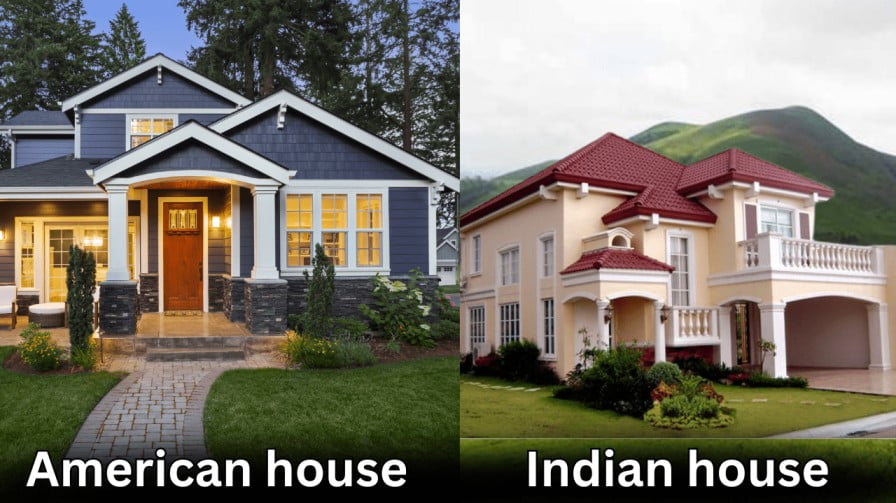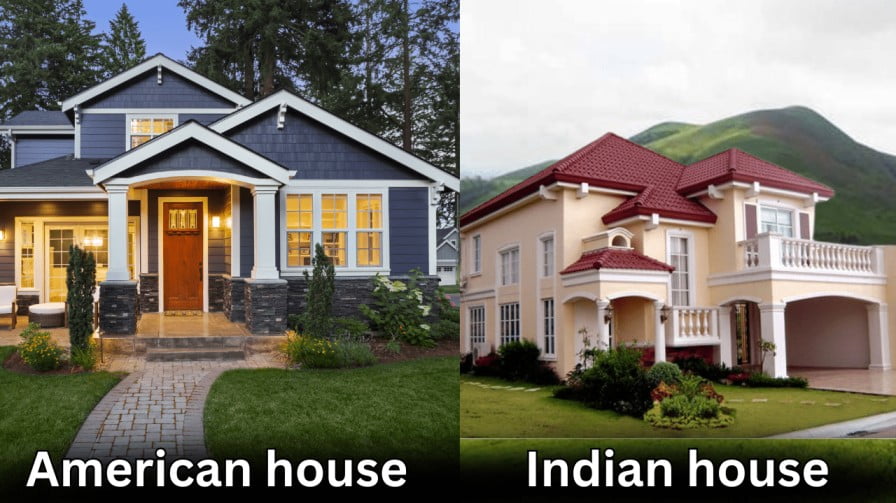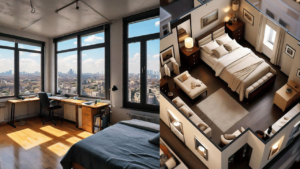Houses are a fundamental aspect of our human life. These are the reflection of the culture, history, lifestyle, and socioeconomic factors of a society. Architecture, materials used, designs, and layouts of houses vary across different countries. In this article, we will explore the differences between Indian and American houses, considering their culture, history, architecture, material, and modern practical aspects.Indian and American house
Indian and American house Historical and Architectural Influences:
Architecture of houses in India and America is backed up by their unique histories and cultural backgrounds.
Indian houses show a blend of traditional and colonial influences. Ancient and traditional Indian architecture emphasizes intricate carvings, use of local materials like wood and stone, open courtyards and verandas, and a close connection with nature. Colonial architecture left its mark on India with British colonial bungalows and Portuguese-influenced houses.
American houses, on the other hand, have been influenced by European styles with colonial, Victorian, and modern styles.
Interior Design and Layout:
Indian houses frequently encourage multi-generational living styles due to strong family bonds. The layout led to the construction of larger houses with multiple rooms and interconnected spaces to accommodate extended families. Privacy is maintained through the segregation of spaces within the house. Courtyards, gardens, and verandas are integral parts of Indian homes that provide natural ventilation and also serve as gathering areas.
American houses tend to be more individualistic and focused on nuclear families. The layout is characterized by a central living area connecting the dining room, kitchen, and bedrooms. Privacy is maintained through room divisions. Backyard spaces are common but they are more private than communal.

Indian and American house Materials and Construction:
Indian houses traditionally use locally available materials like wood, mud, clay, and stone. These materials offer natural cooling and durability and are adapted to the climate. Techniques like adobe construction and thatched roofs are used in rural areas. Modern Indian houses incorporate concrete and steel (or iron) for stability, affordability and cost-effectiveness.
American houses use a broader range of materials including wood, brick, stone and concrete. The availability of resources and advanced construction techniques, like timber framing in colonial houses to modern platform framing, have enabled the creation of diverse architectural styles.
Climate Considerations:
Climate plays a significant role in the architectural choices in both Indian and American houses.
In India, heat is a major concern. Thus, houses are designed to maximize natural ventilation and provide shade. Overhanging roofs, large windows, and courtyards help to keep the interior cool.
In America, houses vary based on the regional climate. Houses in northern (cooler) areas focuses on insulated walls and energy-efficient heating systems to combat cold winters, while in southern (warmer) areas, houses prioritize air conditioning along with sun protection.
Modernisation and Urbanisation:
Both countries have experienced rapid modernization and urbanization and modernization in recent years.
Indian cities have led to a shift towards apartment living due to limited space, increased demand, and modern facilities. Multi-story buildings are common in cities although traditional elements are maintained in their designs.
In America, suburbanization gave rise of single-family houses with attached garages. However, changing lifestyles have brought attention to sustainable architecture, smaller houses and mixed-use developments that promote community engagement.
To know more about one bedroom apartments click here
Cultural Significance:
Indian houses reflect cultural and religious values. Different regions have distinct architectural styles rooted in local beliefs, customs and practices like separate prayer room. Traditional Indian houses are designed according to Vaastu Shastra, an ancient architectural system that aims to create harmony between environment and human living.
American houses may not reflect religious beliefs but they hold cultural symbolism. Architectural styles can symbolize historical periods or social values. For example, Victorian architecture reflects the prosperity and ornate sensibilities of the era. Suburban ranch-style houses represent the post-World War II economic boom and a desire for efficient, family-oriented living. Craftsman-style houses symbolize the Arts and Crafts movement, emphasizing craftsmanship and simplicity.
Conclusion:
Indian and American houses reflect the diverse historical, cultural, climatic influences that impact their architecture.
Indian houses emphasize communal living, intricate designs and a strong connection with nature. It also shows the rich cultural heritage of the country.
American houses focus on functional layout, and individualism and reflect the changing values of modern society.
Both of these architectural differences reflect the unique societies and continue to evolve in response to the changing needs and values of the country.
To know more 3d house construction in India click here





